Cultural Options
The Official Tourist Portal of the Republic of Tatarstan (see https://visit-tatarstan.com/en/about/ ), this website will be very useful for those who want to learn more about the city.
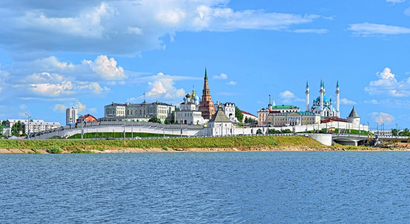
Kazan is often called the «Pearl of the Central Volga Region». It is located in the most picturesque part on both sides of the Volga River. Though the official date of the foundation of the city is considered to be the 12th century. Russians and Tatars have been living here together for many centuries which has influenced the unique culture and traditions of this interesting city in many ways.
The city is the 6th biggest in Russia with a little over 1 million inhabitants. Kazan holds the title of "The Third Capital of Russia".
Kazan Kremlin
The Kremlin has been inscribed on the UNESCO World Heritage list. Within its white limestone walls, visitors can marvel at the stunning Kul Sharif Mosque, a symbol of Tatar culture, and the Annunciation Cathedral, which epitomizes Russian Orthodox heritage. The Kremlin also offers panoramic views of the confluence of the Volga and Kazanka Rivers, providing a picturesque backdrop for memorable photographs.
Adjacent to the Kremlin is the Kul Sharif Mosque, not only a place of worship but also a cultural symbol. Its minarets and blue domes rise majestically against the skyline, and its interior is adorned with intricate designs and calligraphy, reflecting the artistic traditions of the Tatar people.
Transitioning from the spiritual to the educational, the Hermitage-Kazan Exhibition Center, an affiliate of the famous Hermitage Museum in St. Petersburg, showcases a diverse collection of art and artifacts. The center’s rotating exhibitions offer a glimpse into both local and international art scenes, making it a must-visit for art enthusiasts.
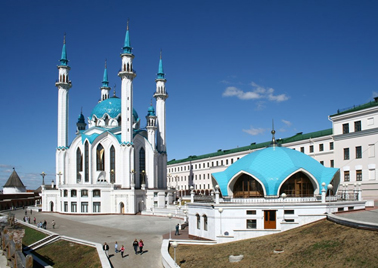
Kazan State Opera and Ballet Theatre
For those interested in the performing arts, the Kazan State Opera and Ballet Theatre presents world-class performances in a grand setting. The theatre’s repertoire includes classic Russian and international works, providing an opportunity to experience the rich cultural traditions of the region.

Bauman street
The Baumana Street is the main tourist and pedestrian zone between the Kremlin and Tokai Square. Tatarstan restaurants, stalls of street painters, boutiques, souvenir shops, fountains that fulfil wishes and kiosks are just a few of its gems that are ready to assure your every need and charm your socks off. Monuments and fountains make for a perfect photo backdrop, with statuary ranging from a bronze carriage of Catherine II to the “thick lazy Cat of Kazan”, a tribute to its feline protectors who fended off mice. Whilst mingling with the locals, the rich chimes of Kazan’s bell tower help bring the vibrant Arbat to life. Baumana street’s historical attractions include houses of the 19th century, a monument to Feodor Chaliapin, and a Russian baroque style Epiphany cathedral. For opportunists seeking for the perfect Russian souvenir, Baumana street is the place to buy everything: Matryoshka dolls, Tatar folk costumes, and one particular favourite of tourists is the Tatar national male headwear “Tubeteika”.
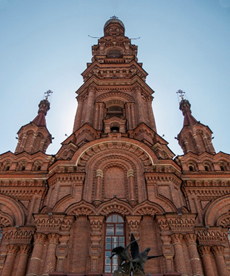
Old Tatar Settlement
This assemblage of historic timbered buildings, dating mainly from the 17th and 18th centuries, marks the quarter where ethnic Tatars were forced to live following the siege of Kazan in 1552. Little of the old settlement remains, though many houses still exhibit colourful, traditional decorations. The most significant building here is the Mardzhani Mosque, dating from 1767. It was the first stone mosque permitted to be built within the city limits.

National Museum of the Republic of Tatarstan
The National Museum of the Republic of Tatarstan is the main museum from which acquaintance with the city and Tatarstan should begin. His exhibition is dedicated to the history and culture of Tatarstan and the Tatar people. Periods ranging from prehistoric to the present day are covered. There is a section devoted to the nature of the region, where stuffed animals living in these parts are presented, and not only. For some reason, stuffed inhabitants from other parts of the country came here. Of great interest to visitors is the carriage of Catherine II, in which she arrived in Kazan.
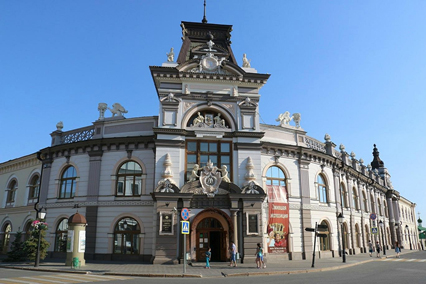
State Museum of Fine Arts of the Republic of Tatarstan
The State Museum of Fine Arts of Tatarstan Republic was established in 1958. The museum exposition primarily consists of paintings from the collection of a Kazan art connoisseur Andrey Likhachov. The museum houses more than 27 000 works. There are some precious works among them — examples of medieval Russian icon painting of the 16th century, European engraving and painting of the 15th–18th centuries, Russian art from the 18th century to the avant-garde, as well as monographic collections of Ivan Shishkin, Nikolay Feshin, Tatarstan artists Baki Urmanche and Haris Yakupov, and others.

The Contemporary Art Gallery of the National Museum of Fine Arts
Gallery of Modern Art is a branch of the state Museum of Fine Arts of the Republic of Tatarstan in Kazan and is located across the intersection from the main building, visited by separate tickets. This is the largest exhibition area of Contemporary Art. On three floors of the building there are various kinds of exhibitions, lectures, film screenings and other cultural events for both adults and children.
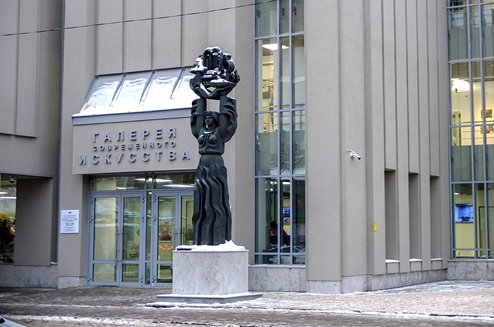
Hermitage-Kazan
This exhibition centre on the territory of the Kazan Kremlin is the first representative branch of the State Hermitage Museum in Russia (outside of its original location of course being in St Petersburg). Themed exhibitions with exhibits from the collection of the famous St Petersburg Museum are regularly held here. The exposition changes approximately twice every year. In addition to its exhibitions, the centre has a rich educational program filled with interactive classes, quests, lectures and master classes.

Lake Nizhny Kaban
is another great place in Kazan where it will be nice to go for a walk. The embankment of the lake is very much loved by locals. On the eastern side of the lake, along the Old Tatar settlement, there is a promenade where families with children and tourists come to feed the Ducks that live in the lake and pigeons.
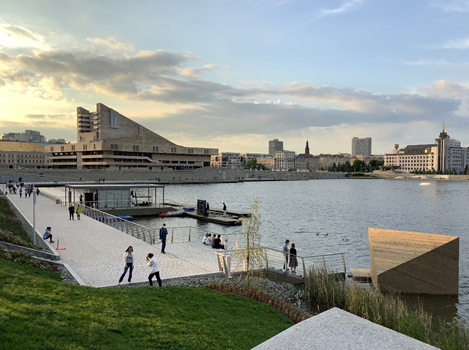
Kremlin embankment
This is perhaps the most popular modern pedestrian zone in Kazan with locals, especially in summer evennings. But it will be interesting and pleasant for tourists to walk along it. The embankment stretches along the city Bank of the Volga from the Kremlin to the National Cultural Center.
The embankment is very well-groomed and beautiful, and every year it appears in a new form, something new appears. In summer, it offers rental of roller skates, Bicycles, children can ride on a children's locomotive. Of course, there are souvenir shops, cafes, restaurants. During the walk there are views of the Kremlin, the registry office, the Millennium Bridge.

Sviyazhsk
The island town of Sviyazhsk near Kazan, Russia is a fascinating enclave whose history spans five centuries. The hamlet occupies a corner of Sviyazhsk Island in Russia’s Zelenodolsk District and is a popular stop on cruise routes from Kazan. Famous for having been erected in only a month’s time, Sviyazhsk attracts increasing numbers of tourists with its thirty plus heritage sites that give the island city the appearance of an open-air museum.

Bolgar
Bolgar Historical and Archaeological Complex is a truly unique museum-reserve, for it is the only example of Bolgar-Tatar architecture from the 8th-14th centuries. A popular tourist attraction, it stands as a testament to the existence of the once-powerful states of Volga Bulgaria and the Golden Horde.
Located 200 kilometers from the Tatarstan capital of Kazan in western Russia, the complex is situated on 380 hectares of land between the city of Bolgar and the village of Privolzhskoye. The area which the museum-reserve now occupies was inhabited during the Neolithic, Bronze and Early Iron Ages.
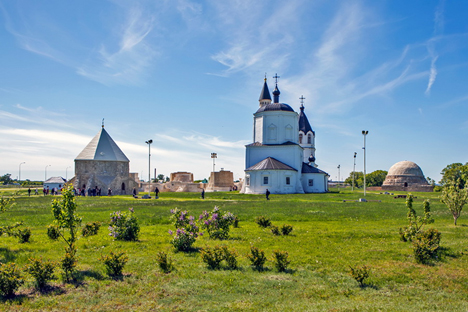
White Mosque
The outstanding historical and architectural treasure of the Republic of Tatarstan as well as the whole of Russia lies in the southwestern part of Sviyazhsk. This area contains an architectural ensemble of buildings of years gone by, for example the Nikolskaya Church built by the artel of Pskov masters led by Ivan Shirya between 1555-1556 which is a rare type of bell-tower church, 43 metres high. Another is the the single domed Cathedral of the Assumption of the Blessed Virgin Mary where the 1,080 square metres of colourful ancient fresco wall paintings from the second half of the 16th century have almost entirely survived. The most significant of these frescoes is the only image of Tsar Ivan the Terrible made during his lifetime surrounded by boyars and voivodes in the altar area of St Christopher which is also the only surviving fresco in the world, where the saint, according to the apocryphal version, is depicted featuring a dog’s head. Out of the residential and commercial buildings in the area, the Archimandrite Corps of the 17th century, the fraternal building of the 18th century, and the buildings of the monastery school of the 18th century among others have also all been carefully preserved.
